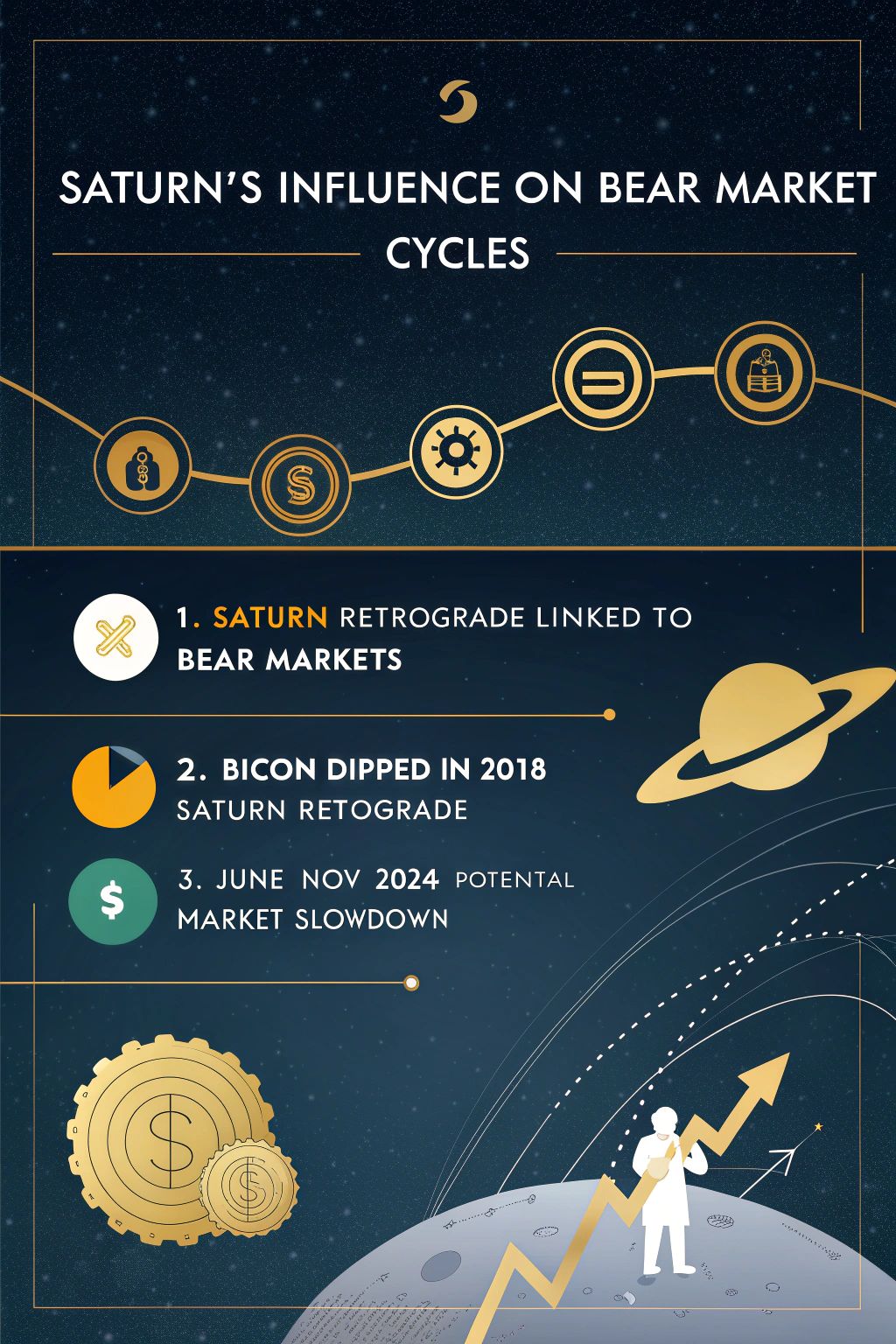Markets can feel tricky, especially during bear cycles. Did you know Saturn’s retrograde periods often align with market slowdowns? This blog will explain how Saturn’s motion may impact stock and crypto trends.
Keep reading to spot patterns and plan smarter investments!
Principales conclusiones
- Saturn’s retrograde periods often align with bear markets, creating volatility in stocks and cryptocurrencies. For example, during May–September 2020, the S&P 500 dropped sharply amid COVID-19 fears.
- Historical data shows Bitcoin tends to dip during Saturn retrogrades. In 2018, its price fell from $8,000 to $6,500 during this phase.
- Key upcoming dates include June 30–November 4, 2024 (Saturn retrograde). Markets may slow down or face big surprises during these months.
- Planetary interactions like Saturn-Uranus aspects add stress to financial markets. This was seen in January 2021 when crypto prices showed wild swings.
- Traders can prepare by watching patterns tied to Saturn cycles and focusing on safe assets like strong-value stocks or Ethereum for long-term stability.

Understanding Financial Astrology

Financial astrology links planetary cycles to market trends. It shows how cosmic movements may influence stocks, interest rates, and cryptocurrency shifts.
Definition and relevance
Financial astrology links planetary movements to market trends. Saturn, known as the ruling planet of discipline and restriction, plays a key role here. Its cycles often connect with financial contraction or downturns.
Historically, markets show signs of fear and lower investor psychology during major Saturn transits.
Saturn retrograde brings shifts in economic cycles, aligning closely with bear markets. “Saturn’s energy demands patience,” say astrologers studying Vedic patterns. This is why many associate it with cautious stock picking and falling valuations.
Historical data shows correlations between its phases and events like drops in S&P 500 rates or rising interest rates.
Markets react sharply under certain planetary aspects involving Saturn—leading right into its influence on finance next!
Historical impact on financial markets
Saturn retrograde often lines up with market volatility. During 2020, from May 11 to September 28, financial markets tumbled as COVID-19 hit hard. Investors reacted emotionally, causing sharp drops in the S&P 500 and other indices.
The same trends appeared in 2016 between March 24 and August 13 when Brexit fears wreaked havoc on global stocks.
These patterns show Saturn’s astrological role influencing investor sentiment rather than direct outcomes. Overreactions during these periods can lead to temporary bear markets or sudden downturns.
Historical data reveals these dips may create buying opportunities for value stocks or strong assets like Bitcoin after Saturn’s pullback ends. Market analysts view such phases through technical analysis backed by historical charts and cycles tied to outer planets like Saturn.
Saturn’s Role in Astrology and Finance
Saturn is known as the planet of discipline, structure, and limits in astrology. Its slow movement often lines up with major shifts in market trends and investor behavior.
Characteristics of Saturn in astrology
Saturn represents discipline, responsibility, and caution in astrology. It reflects the principle of limitation and teaches through hardships. Known as the “Taskmaster,” it forces personal growth by testing patience and endurance.
Its energy often symbolizes contraction, fear, and strict boundaries. Saturn challenges people to confront their fears but rewards persistence with wisdom.
In financial astrology, this planet affects market trends marked by hesitation or pessimism. It signals slow progress but lays foundations for sustainable growth. During retrogrades, its influence intensifies reflection on investments or strategies.
These qualities tie closely to shifts in crypto markets during such phases. Historical data shines more light on Saturn’s role in finance next!
Historical data on Saturn’s influence on markets
Saturn’s position in astrology often aligns with financial market shifts. Its retrograde periods historically carry patterns of volatility. The table below highlights key instances.
| Date Range | Market Event | Saturn’s Role |
|---|---|---|
| September 7 – October 10, 2009 | Recovery post-2008 crisis | Saturn retrograde ended before crucial market recovery |
| March 23 – August 17, 2018 | Tech sector volatility | Occurred during Saturn retrograde |
| March 14 – July 1, 2020 | Pandemic sell-off and recovery | Retrograde overlapped with extreme market fluctuations |
| June 4 – October 23, 2022 | Bearish crypto market | Saturn retrograde coincided with Bitcoin’s decline |
These dates show a curious overlap between Saturn’s retrograde and major market movements. Patterns reflect shifts during periods of economic stress or recovery.
The Impact of Saturn Retrograde on Crypto Markets
Saturn retrograde often stirs uncertainty in the crypto world. This shift can shake market sentiment, creating unexpected price swings.
Overview of Saturn retrograde phases
Saturn retrograde happens every year, lasting about four to five months. In this phase, Saturn appears to move backward in its orbit. The 2024 retrograde starts on June 30 and ends November 4.
These periods often bring reflection and delays, especially in markets like crypto or stocks.
October-November 2024 will also see stationary phases of both Saturn and Jupiter. This overlap can amplify market volatility. Historically, such alignments influence financial sentiment and bring caution among traders.
Specific historical impacts on Bitcoin and other cryptocurrencies
Strong Saturn retrogrades often influence financial markets, including cryptocurrencies like Bitcoin. These periods bring volatility and psychological shifts among investors.
- In 2018, during Saturn’s retrograde from April 17 to September 6, Bitcoin’s price saw a sharp decline. It dropped from $8,000 in May to nearly $6,500 by the end of the period.
- The 2020 Saturn retrograde (May 11–September 29) aligned with significant price fluctuations. Bitcoin first dipped in June before rebounding above $10,000 by mid-July.
- During the 2021 retrograde (May 23–October 10), Bitcoin fell from $50,000 in May to $29,000 in July. This created fear within the market but gave long-term investors opportunities for cheaper entry points.
- The June 2024 retrograde is projected to have similar effects on crypto markets. Trends suggest downturns as cautious investor behavior aligns with Saturn’s themes of contraction and evaluation.
- Saturn often highlights market caution over risky investments during its retrograde phase. Historically, this pushes traders away from volatile assets into stable ones like Ethereum or even tethered tokens.
- Longer-term impacts observed show that post-retrograde phases lead to gradual recoveries in Bitcoin prices as confidence rebuilds among participants.
- Retrogrades often coincide with major shifts in global economic policies or Federal Reserve announcements, creating ripple effects across digital assets worldwide.
These examples underline how Saturn’s patterns leave clear marks on cryptocurrency trends over time while offering strategic insights for savvy traders seeking better opportunities amidst uncertainty.
Predicting Bear Market Cycles with Saturn
Saturn’s position often aligns with major shifts in market trends. By studying its cycles, traders might spot patterns tied to bear markets or volatile phases.
Key dates for Saturn’s influence in upcoming years
Saturn plays a big role in shaping market trends. Knowing key dates can help traders understand its potential impact on bear markets and volatility.
- June 30, 2024: Saturn begins its retrograde motion in Pisces. This phase pushes investors to rethink financial and emotional limits. Markets may experience slowed progress during this time.
- November 4, 2024: Saturn ends its retrograde and shifts direct again. Forward momentum could return to stocks and crypto markets. Traders might see steadier trends resurface.
- October-November 2024: During this period, both Saturn and Jupiter reach stationary phases. Markets often become unpredictable or stagnant when these planets pause their motion.
These dates highlight moments where Saturn’s influence could reshape market dynamics. Use them to plan ahead wisely in trading or investing decisions.
Projected trends for crypto markets during these periods
Upcoming Saturn retrograde periods could bring tighter financial scrutiny. Crypto traders may see cautious behavior in the market, leading to slower growth or temporary drops. Historically, similar cycles have shown overreactions from traders.
This creates opportunities for buying assets at lower prices.
Bitcoin and other cryptocurrencies might face short-term declines during strong planetary alignments like Saturn’s trines and sextiles with Uranus or Mercury. These shifts often lead to reassessments of risks by investors.
Expect increased selling pressure but also chances for strategic long-term investments as fear drives undervaluation moments in crypto markets.
Saturn and Other Planetary Influences on Market Volatility
Saturn doesn’t work alone in shaping market swings. Its dance with planets like Uranus and Jupiter often shakes up prices, creating ripple effects that traders can’t ignore.
Combined effects of Saturn with other planetary aspects
Saturn interacting with Mercury, Venus, or Mars can shake market trends. During retrograde, Mercury influences communication breakdowns in financial markets like the S&P 500. This causes shaky investor confidence and high market volatility.
Venus impacts value systems, often leading to fluctuating stock prices and uneven crypto performance.
Mars adds fuel with aggression and sharp movements in trading patterns. For instance, its influence on the NYSE chart during December 2020 coincided with notable price changes. These planetary interactions amplify Saturn’s weight on bear market cycles, making it vital for traders to watch these alignments closely.
Case studies: Bitcoin’s response to planetary alignments
Bitcoin’s price movements often surprise analysts. Some link these shifts to planetary alignments like Saturn and Uranus influences.
- December 21, 2020: Jupiter-Saturn Conjunction
The rare alignment impacted global markets. Bitcoin surged above $23,000, setting a new high after this event. This sparked discussions about celestial influence on financial trends.
- January 21, 2021: Mars Conjuncts Uranus; Squares Jupiter and Saturn
This was a tense period for cryptocurrencies. Bitcoin faced sharp price swings around $30,000. Experts noticed increased volatility as Mars’ energy mixed with heavy Saturn aspects.
- Saturn Retrograde Phases in Past Crypto Markets
During some retrogrades, Bitcoin often dropped or stalled growth. For instance, in May 2021’s retrograde phase, Bitcoin fell from $58,000 to below $40,000 within weeks.
- Uranus in Taurus Period (2018-2026)
Uranus disrupts stable assets like traditional currencies during its Taurus transit. Since this began in 2018, Bitcoin has grown unpredictably but shattered many records by crossing $69,000 in late 2021.
- Combined Aspects of Mars-Uranus-Saturn
Historical charts reveal market turmoil under such patterns. For example, tension between Uranus’ fast changes and Saturn’s restrictions aligned with sudden crypto dips throughout early 2022.
Astrology plays an intriguing role in explaining crypto market volatility through such alignments and patterns!
Uranus in Taurus and Its Impact on Bitcoin Price Movements
Uranus in Taurus often shakes up stability and redefines value. It has a history of jolting markets, especially assets tied to innovation like Bitcoin. Since 2018, Uranus entered Taurus and triggered unpredictable price swings.
This transit challenges traditional finance systems while boosting interest in cryptocurrencies.
October-November 2024 brings significant planetary activity as Jupiter turns stationary in Taurus alongside Saturn’s Aquarius stationing. Such alignments point to sharp volatility for the stock market and crypto prices.
Traders should brace for sudden crashes or spikes during this period, making cautious moves essential to avoid financial pitfalls.
Trading Strategies During Saturn Retrograde
Saturn retrograde can shake up market trends and create sharp price shifts. Stay cautious, plan wisely, and focus on spotting patterns for smarter trades.
How to adjust trading strategies
Focus on stocks with strong balance sheets and steady growth. Companies like Apple and Microsoft have weathered financial storms before. Reassess your crypto holdings and align them with long-term goals.
For example, if risk tolerance is low, consider scaling back high-volatility assets like Bitcoin.
Study Saturn’s retrograde periods in natal charts to time the markets better. Past trends suggest bear markets often align with these astrological phases. Plan trades carefully during S&P 500 dips linked to astrological aspects between Saturn and Uranus.
This leads into analyzing other planetary impacts on cryptocurrencies next.
Specific actionable tips for cryptocurrency traders
Trading during Saturn retrograde can feel unpredictable. Smart strategies can help you manage market volatility.
- Track Saturn Retrograde Dates
Check astrological calendars for Saturn retrograde periods. For example, in 2023, it occurred between June 17 and November 4. Be prepared for similar phases ahead.
- Analyze Historical Trends
Study past bear markets linked to Saturn’s cycles. Bitcoin often dips during these times, like in early 2022 when prices fell by nearly 50%. Use this knowledge to plan trades wisely.
- Avoid Panic Selling
Bear markets test patience. Crypto prices may drop sharply but avoid quick decisions based on fear. Instead, hold assets with long-term stability like Bitcoin or Ethereum.
- Watch Market Sentiment
Monitor psychological trends on platforms like Twitter or YouTube during these periods. Negative sentiment often signals lower confidence in crypto markets.
- Focus on Undervalued Coins
Saturn retrogrades can highlight undervalued assets with growth potential. Look into low-priced coins backed by strong projects for safer investments.
- Set Stop-Loss Orders
Minimize risks by setting stop-loss orders on your trades. This tactic works well during high-volatility markets tied to astrological influences.
- Look for Bull Market Reversals
Saturn’s retrograde often leads to clear market shifts after its end date. Pay close attention when signs of a bull market begin emerging again.
- Educate Yourself on Dashas and Horoscopes
Learn how vedic astrology tools like dashas and horoscopes connect with market trends to make informed moves.
- Keep an Eye on Yield Curves and Federal Policies
Stay updated on the Federal Reserve announcements or yield curve changes during these times since they also impact crypto prices heavily alongside Saturn’s effects.
- Diversify Your Portfolio Wisely
Spread your investments across multiple coins or sectors during slowdowns caused by planetary movements to reduce risk long-term while staying cash-ready for future opportunities!
Conclusión
Saturn casts a long shadow on bear market cycles. Its influence often signals caution and slowdowns, leaving traders alert. While it may not control markets directly, its retrograde periods show clear patterns of volatility.
Understanding these shifts can guide smarter investing moves. Stay sharp and plan wisely during Saturn’s dance with the stars!
Preguntas frecuentes
1. What does Saturn have to do with bear markets?
Saturn, in financial astrology, is believed to influence market trends and cycles. Its orbits are often linked to periods of market volatility, including bear markets.
2. Can Saturn’s position predict stock market changes?
Some experts in Vedic and Western astrology suggest that Saturn’s resonance with the share market can signal shifts between bull and bear markets.
3. Who was Louise McWhirter, and why is she important here?
Louise McWhirter was a pioneer in financial astrology who studied how planetary movements like Saturn’s could affect the S&P 500 and other indices during financial crises.
4. Is this idea based on science or belief?
Financial astrology blends astrological concepts like rashi with stock market data. While it isn’t mainstream science, some traders use it alongside traditional analysis for mentorship on timing investments.
5. How does Saturn differ from other planets in its impact on markets?
Saturn is often associated with slow-moving yet profound effects on economic cycles, unlike faster planets that may trigger short-term news-driven spikes or dips in the share market.




